Spectrum Technologies has been at the forefront of laser wire processing technology for over 30 years; developing and applying leading edge technology to provide solutions to problems in advanced manufacturing, and pioneering the use of laser technology to solve a range of issues.
Some background information relating to the technology we have developed and commercialised into the product range we offer today is provided in this section.
UV Laser Wire Marking: Explaining Our Technology
UV laser wire marking was originally developed in 1987 by Spectrum researchers to meet the needs of the international aerospace industry for a means of safely applying permanent identity codes to non-stick PTFE/Teflon and similar wire insulations, as well as fibre optics.
The UV laser marking process, pioneered by Spectrum, causes no damage and no change to the mechanical or electrical properties of the wire.
Above right: Hot stamp marked wire section illustrates significant deformation and potential for damage to the wire insulation.
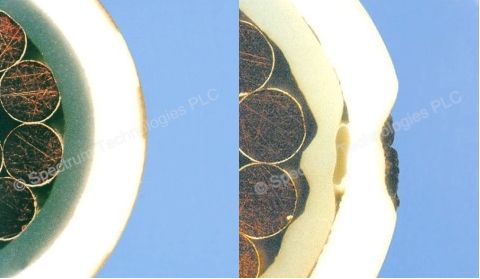
In direct contrast, the old hot stamp method, is views as an aggressive and potentially damaging process; as a result it is banned under SAE AS50881 (previously MIL 5088L) and similar specifications.
Ultra violet (UV) laser wire marking is now well accepted as a manufacturing process within the international aerospace industry. It is currently employed in the initial stages of electrical systems manufacture on virtually all leading edge commercial and military aerospace programmes in North America and Europe.
Lasers have been around since 1960 and are now widely used in a variety of applications from the ubiquitous bar code reader at the supermarket check out to the “read” head in CD players at home, to laser welding and cutting equipment on the auto production line. Yet many people still view lasers as remote “star wars” technology.
In reality laser beams are composed of light, one of the many forms of energy. However, unlike “normal” light sources, they have some very special characteristics. While everyday light sources, from the sun to a light bulb, radiate in all directions and over a wide wavelength range, lasers have narrow directional pencil like beams and operate at precise and narrow wavelengths (single colour). This key difference gives lasers a big plus when using them for material processing of whatever nature, namely precision and control.
It is of paramount importance to note that not all lasers are the same. In fact there are many hundred different types. Generalizing, however, we can split them into two groups:
- Shorter wavelength ultra violet (UV) and visible lasers: Enable materials to be “cold” processed – they create little or no significant heat effect in the work piece whether it be marking, cutting or some other process.
- Longer wavelength infra-red (IR) lasers: Interact with, or process materials primarily by thermal means, i.e. by direct heating – perfect for welding and cutting metals and other materials which are non-heat sensitive or where thermal side effects are acceptable to the user.
Selection of the right laser and wavelength for a particular process is therefore of key importance. Spec Tech laser marked wire
The “cold” UV laser wire marking process developed by Spectrum Technologies is quite different and is based upon a change in colour of titanium dioxide (TiO2) pigment brought about by the laser. This normally white pigment was already used in aerospace wire insulations for other purposes.
In the wire marking application, the UV laser beam changes the color of the TiO2 particles already contained within the wire insulation by rearranging their crystalline structure on a microscopic scale. The rearrangement is permanent for all practical purposes. This gives the TiO2, and thereby the insulation, a blackish color, hence creating a colored or marked wire surface. According to tests carried out by a variety of end users, there is no burning, no significant material removal or change in the wire’s mechanical or electrical properties. The mark is embedded to a depth typically of the order of 20 micron (0.0008 inch) thereby providing permanence against abrasion and fluids.
Permanence against perhaps less obvious factors has been tested by plunging wire samples into liquid nitrogen to test the effect of low temperatures (-196°C) and holding wires for several hundred hours at or above their maximum rated temperature.
Samples have been tested at up to 310°C without ill effect. Samples have also been exposed to intense ultra violet to simulate the long term effect of sunlight.
Virtually every test carried out on properly composed and marked wire shows that there is no material change in the mark.
Perhaps the best demonstration of this is to place laser marked wires in hot hydraulic fluid, such as Skydrol, and leave them to soak for 24 hours. On removal, samples have been given a “real life” test and the marked wire has been immediately rubbed, while still wet. A UV laser marked wire sample has never failed this test.
The result graphically illustrates the permanence of Spectrum’s laser mark compared to typical ink marks.
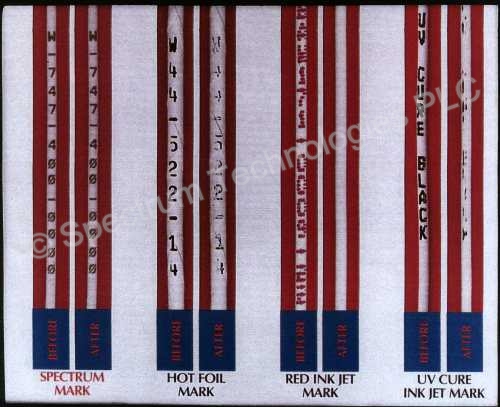
Laser Wire Stripping: Explaining Our Technology
Wire stripping is simply the removal of the insulation, which covers the electrically conducting wires, in order to make the wire ready for termination.
Conventional wire stripping techniques have developed to include mechanical, abrasive, chemical or thermal methods. But each method has its associated problems such as conductor damage, slow processing speed, a lack of precision and poor quality.
In contrast, laser wire stripping has a fast process time, excellent precision and outstanding process control. Most importantly, laser wire stripping eliminates contact with the wire and by using the correct laser type it is possible to completely eliminate the risk of damage to the conductor or shield.
Background to Laser Wire Stripping
Modern electronic devices, as well as the communications systems that link them, are full of wire. From the enormous conductors that route local-area-network data around microwave communications systems to the miles and miles of wiring that connect all the critical control and communications systems on aircraft and other transportation systems, to the minute strands that provide interconnections in microelectronic systems or carry the signals in medical implants, wires are indispensable for moving signal and power about.
The traditional method of mechanical wire stripping employs metal blades to cut through the insulation, enabling it to be pulled away over the end of the conductor. However, even though modern mechanical stripping equipment incorporates shaped blades, automatic wire handling and precise blade control, it still shares one thing with the handyman’s wire stripper: both need careful attention to avoid wire damage.
Historically, designers and manufacturers had to accept a degree of damage to the wire conductor from the use of mechanical blades for stripping. To accommodate this, the electrical resistance of the wire is often specified with a higher tolerance than would otherwise be necessary; which essentially means specifying a larger conductor; this makes the whole wire larger and more costly.
In critical manufacturing applications such an approach is unacceptable and, where quality is all-important, damage free laser wire stripping comes into its own. For state-of-the-art applications it is critical to be able to strip insulation precisely from wire without damage to the conductor. Laser-based wire strippers accomplish this simply, by relying on the ability of light to selectively remove non-metallic insulating materials while leaving the metallic conductor completely untouched.
Above right: The same cable laser stripped.

Manual or semi-automatic mechanical, chemical or thermal wire stripping methods have well known quality assurance problems. The mechanical blade is the most widely used tool to strip wires. It is best suited to cutting through the insulation on a regular shaped circular cross-section wire; i.e. the humble single core wire. Even so, damage to the conductor may result from the use of blades that are worn or that do not fit the shape of the wire correctly or from inadequate control of the stripping process. Furthermore, mechanical methods are not well suited to stripping twisted or shielded cables that do not have a regular, circular cross-section.
Very long process times and environmental issues impair chemical wire stripping techniques. These chemical processes often use hot sulphuric acid or hydrogen peroxide, which are difficult to use and control. In addition the chemicals are quite reactive and require careful handling and disposal must be carried out with due regard to the environment and current legislation.
Thermal methods require very fine process control and frequent calibration in order to maintain quality. Thermal processes also often require a secondary operation to remove any remaining strands of insulation from around the conductor.
Laser wire stripping, in contrast has a fast process time, excellent precision and outstanding process control. Most importantly, laser wire stripping eliminates contact with the wire and by using the correct laser type it is possible to completely eliminate the risk of damage to the conductor or shield.
The Development of Laser Wire Stripping
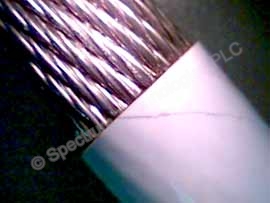
Research into laser wire stripping originated in 1976 when NASA initiated a programme to develop a better method of stripping wire to overcome problems encountered in the production of the electrical wiring systems during the development of the Space Shuttle. This research was prompted by the need to be able to strip electrical wire with very thin insulation used on aircraft and spacecraft where, to save weight, very lightweight and fine gauge wires are often used. The result of their research was the first laser wire stripping machine.
NASA compared the effect of various types of lasers on the insulating and conducting materials of the wire and found that the CO2 laser was the best choice for the task at hand. During the laser wire stripping process the energy or radiation emitted by the laser is absorbed strongly by the insulating material. As the laser penetrates the insulation it vaporises the material through to the conductor.
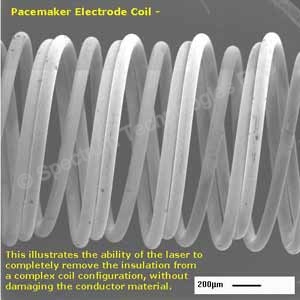
However, the conductor strongly reflects the radiation at the CO2 laser wavelength and is therefore unaffected by the laser beam. Because the metallic conductor is essentially a mirror at the wavelength of the laser, the process is effectively “self terminating”, that is the laser vaporises all of the insulating material down to the conductor and then stops, so no process control is required to prevent damage to the conductor.
Since 1987, when RtMc, Inc, now Spectrum Technologies USA, Inc, introduced the first commercial CO2 Laser Wire Stripping machine, there has been an increasing need for the further development of laser technology to enable an increasing range of insulating materials and wire types to be stripped. This is due to the development of new insulation types, new ways of extruding the insulating material onto wire, varying bonding properties and the trend for smaller, lighter-weight wire applications, combined with the development of new products using these wires.
Laser Wire Stripping Today
During this period Spectrum Technologies has become the leading manufacturer and supplier of Laser Wire stripping products to international industry, having delivered many hundreds of units to customers around the World. Spectrum’s SIENNATM range of laser wire strippers has been developed incorporating various lasers and delivery systems and can successfully remove almost any insulation from any wire form.
There is an increasing need for products to become light-weight, more reliable, more efficient and more cost effective as conventional methods for stripping wire will become increasingly outdated. Laser wire stripping provides many advantages over conventional methods. Some of the advantages and benefits are:
- No conductor damage – the laser cannot damage the metal conductor even if it is plated with another metal such as tin or silver – reduces quality assurance requirements and enables designers to specify tighter tolerances and user lighter weight wires
- Able to process 99% of all insulation types – one piece of equipment can cope with a wide variety of wire and insulation types and can process a range of wire types without the need for time-consuming changes in set up
- Highest achievable strip quality – guarantees reproducible results and maximises yields, thereby reducing costs
- Able to process multiple wires simultaneously – increases productivity
- Able to strip a variety of wire sizes from less than 25 µm up to 25m (0.001 – 1.000 in.) diameter – one process supports damage free stripping across the widest range of wire sizes
- Able to strip a variety of wire forms the same machine can process flat, round, twisted, or shielded cable with little or no tooling changes – improves equipment utilisation and productivity
- Able to hold tight tolerances of +/- 25 µm (0.001 inch) – for precision applications
- Variable strip patterns can be programmed to remove the insulation at any location on the wire – see below
Because laser wire stripping is a non-contact process and the beam can be controlled very precisely, it is possible to direct the laser beam to achieve a variety of stripping patterns, many of which are virtually impossible by other means, as shown below:
- End strip – Crosscut or Crosscut & slit
- Windows
- Mini Window
- Angled cuts
- Programmable patterns at any point on wire or ribbon cable.
Laser wire stripping can process the following wire and cable insulation types and forms:
Variable Cable Type 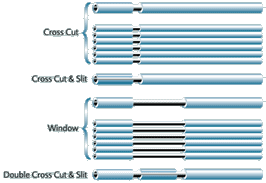
- Single core wire
- Twin leads
- Twisted pairs
- Multi-conductor cables
- Shielded/screened wire and cable
- Ribbon cable
- Coaxial cable
- Complex 2D and 3D shaped conductors, e.g. coils
Variable Cable Size
- 1 AWG to 50 AWG and smaller
- Ribbon and flat cable up to 285 mm (11.4″) width
Insulation Capability
- PTFE /Teflon®
- Silicone
- PVC
- Kapton®
- Mylar®
- Kynar®
- Fiberglass
- ML
- Nylon
- Polyurethane
- Formvar®
- Polyester
- PolyesterPolyesterimide
- Epoxy
- Enameled coatings
- DVDF
- ETFE /Tefzel®
- Milene
- Polyethylene
- Polyimide
- PVDF and other hard, soft or high temperature material
Laser Wire Stripping in Practice
In our mainstream SIENNA wire strippers the laser beam is focused down to a very small spot size and is passed over the wire at a pre-set speed. The laser then vaporises the selected areas of insulation, removing it in a narrow line.
As noted previously, the laser does not damage the wire conductor because the metallic materials are highly reflective to the CO2 laser beam, whereas the insulating materials are generally highly absorbing. As the beam passes over the wire it cuts precisely through the insulation, rather like an invisible hot knife through butter, creating a neat cut down to the conductor and leaving the insulation to be easily removed. Through a combination of moving the work piece and the beam, a variety of strip geometries are possible from our different products, depending upon the requirements of the application, such as cross-cuts and slits windows, etc.
SIENNA laser wire strippers may be used either as stand-alone equipment or as part of an automated system. Where the equipment is to be used as a stand-alone facility the wire may be processed as a batch, hand loaded by the operator, either singly or set up in groups on a tooling plate. Setting up on a tooling plate speeds up the stripping process and increases productivity in situations where batches of the same wire type require processing; once set up, the plate is loaded into the wire stripper which makes one or more passes across the wires, stripping them in parallel.
Alternatively, our wire strippers can be automated by the provision of a SIENNA AWH automated wire handling system as part of an integrated set up in which wire is fed automatically through the stripper from a reel. In this way jobs can be automatically processed as batches via the SIENNA system controller. For higher levels of automation, our products are also available to systems integrators who may need to integrate them into more complex automation systems.
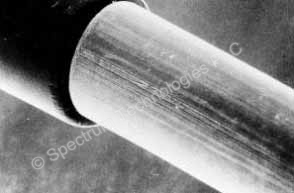
To facilitate the use of the SIENNA wire strippers, Spectrum Technologies provides a range of ancillary equipment, including control systems, chillers and air purification units to provide a complete turn key solution to each customers requirements.
When the laser beam interacts with organic materials, it typically produces process fumes and particles, which must be removed from the vicinity of the equipment. To do this we can provide the ACS-5 for air extraction and purification for use with all SIENNA equipment. Alternatively, if the customer has suitable venting and filtration systems available, the exhaust outlet on SIENNA wire strippers can be hooked up directly to this.
For some applications we need to use other laser types, either to deal with more difficult insulation types or to work at smaller dimensions.
If you have a need that cannot be met with one of our mainstream SIENNA products, we will be happy to discuss your application with you. We can undertake process evaluation and development in our application laboratories and if appropriate we can tailor a system accordingly (see below).
Future Developments and Applications
New technological developments and increased innovation are continuing in all market sectors. Advances in new product development are changing the way devices or components function, look and communicate. With these new advances, the wiring of these devices continues to change: circuitry is getting smaller and faster while wire manufacturers are developing new insulating materials, smaller diameter wires with new cable and wire configurations that are able to surpass previous performance. As materials and component designs advance and get smaller, they require improved manufacturing processes to ensure higher product quality levels are maintained while production costs are lowered.
As products become lighter weight, more reliable, more efficient and more cost effective, conventional methods for stripping wire are becoming increasingly outdated and unacceptable. Whether it is damage to the wire, the need for constant monitoring of blades to ensure quality standards or the high cost for replacement parts, designers and manufacturers are discovering that they need to find alternatives to these methods.
Spectrum Technologies is focused on providing laser based technology solutions for the removal of insulating materials, whether for metallic wires or for fibre optics as well as for other applications in advanced manufacturing. As we continue our research into the development and application of new laser process technology, please feel free to contact us if you have a problem that you would like to discuss with us that cannot be met with one of our standard products.
Spectrum laser systems are used across a wide range of industries and for many different applications.
Below you will find some examples of situations where our products can be used and if you visit our wire sample gallery you will find photos of a range of wire and cable samples that have been stripped with SIENNA laser wire stripping equipment.
If you have a laser application which isn’t listed on these pages and you would like us to mention it please contact us.
You can also search the site for specific wire types using the search box at the top right of the site.
Wire / Cable Marking
Nova laser and NovaJet ink-jet wire marking systems offer high quality, permanent and highly legible identification of wire and cable. We have a range of products to meet all throughput requirements, as well as automation accessories to maximize productivity.
- Entry-level production or low volume, MRO (laser):Nova 50-100i Series
- Low volume production (laser): Nova 800
- Medium volume production (laser): Nova 820; Nova 840
- High volume production (laser): Nova 860; Nova 880
- Wire Handling & Automation
Polymer Wire / Cable Stripping
SIENNA Infrared CO2 laser stripping systems, in linear, single or dual axis or rotary beam delivery configurations can strip the majority of wire and cable constructions used in most electronic manufacturing applications.
Wire/Cable Up to 7mm (0.04″) OD*:
- Fixed beam operations (parts move on x-y stage below – Class 4): SIENNA 225FB
- End strips only: SIENNA 210S; SIENNA 325S; SIENNA 350S
- End strips and window strips: SIENNA 210D; SIENNA 325D; SIENNA 350D
Wire/Cable Larger than 7mm (0.04″) OD*:
- Strips lengths up to 200mm (7.9″): SIENNA 530 AND SIENNA510
Automated Laser Strip, Measure & Cut
SIENNA 700 wire strippers can be automated to perform a strip, measure and cut operation. This is achieved by pairing the fast, non-damaging accuracy of laser stripping, with the convenience and efficiency of a mechanical measure and cut system.
- SIENNA 200AWH and SIENNA300AWH versions are available
Cable Shield Cutting
SIENNA linear dual axis and fixed beam Scriber systems are used to cut the metal shields in micro or pico-coaxial cable assemblies. The laser will score a line across a solder dipped shield which can then be easily snapped and removed to expose the underlying dielectric.
- Fixed beam system (parts move on x-y stage below – Class 4): SIENNA 220SRFB
- End strips only: SIENNA 220SRD
- End strips and windows: SIENNA 220SRD
